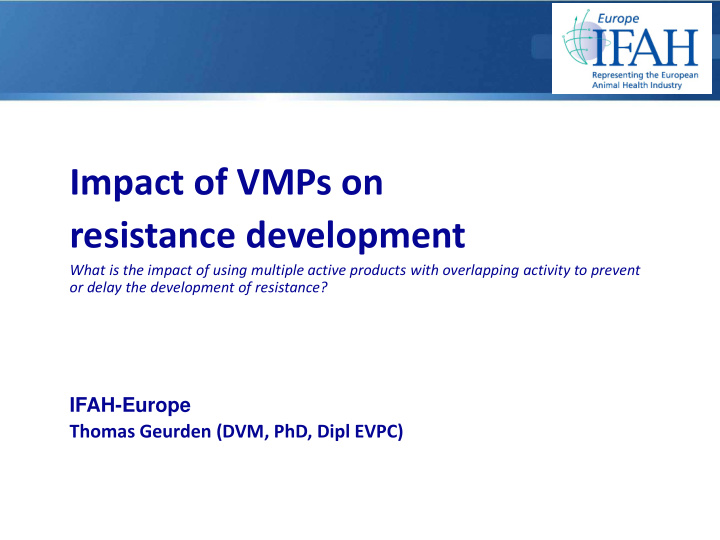



Impact of VMPs on resistance development What is the impact of using multiple active products with overlapping activity to prevent or delay the development of resistance? IFAH-Europe Thomas Geurden (DVM, PhD, Dipl EVPC)
AR management Options for management of AR • Maintaining adequate refugia of susceptible worms, mainly on pasture • Treatment when needed targeted treatment principle • Treatment with effective drugs = minimise the opportunity for resistance genes to be selected in a population • Combinations of two or more active molecules.
Combination therapy Combination therapy is already used for the control of nematodes in livestock • Use in sheep and later cattle nematode control was initially for the control of drug-resistant parasites 1. 2-way ( e.g. benzimidazole + levamisole; macrocyclic lactone + levamisole; macrocyclic lactone + spiroindole) 2. 3-way ( e.g. benzimidazole + levamisole + macrocyclic lactone) 3. 4-way ( e.g. benzimidazole + levamisole + macrocyclic lactone + salicylanilide).
Benefits of combination therapy Benefits of combination products: 1. Increase potency of the chemotherapeutic product. 2. Increase the spectrum of activity. 3. Delay or prevent the emergence of drug resistance. • Early modelling around use of insecticides suggested combinations are far superior to rotations or sequential use. • Some disagreement, principally because of assumptions made ( e.g. half-doses, treatment of whole population). • General agreement that if the right conditions are met , combinations will greatly delay the development of resistance. • Combinations are extensively used in treatment and/or control of malaria, HIV, tuberculosis, weeds, insect pests, cancer.
Rationale of combination therapy Combination of two molecules efficacious against the same intestinal nematodes, but through a different mechanism of action < molecule 1 > < molecule 2 > Complementary action (key factor 1) The parasite strains least sensitive to molecule 1 will be eliminated by the combined molecule 2 (and vice-versa).
Benefits of combination therapy Combinations slow resistance because fewer resistance genotypes survive treatment • • thereby increasing efficacy and the diluting effect with unexposed parasites • i.e. maximise the benefit of ‘refugia’ • The presence of ‘ refugia ’ is essential to realise the full benefit from combinations (key factor 2) • In the complete absence of refugia a combination treatment has no advantage.
Benefits of combination therapy Combination therapy for the prevention of AR development in nematodes in livestock • Four (five) nematode models built independently of each other: • Barnes, Dobson & Barger (‘Worm World’; Australia) – mono-specific but built into a multi-species model for monepantel experiments. • Leathwick (New Zealand) – general nematode disease. • Learmount & Taylor (UK) – multi-species. Smith (USA) – mono-specific; general nematode disease. • Dobson & Hosking (AUS) – Risk Management Model for Nematodes TM multi- • species/cost-benefit. • Leathwick has undertaken empirical studies to validate his model.
Benefits of combination therapy • Key outputs from these models are consistent: • Combination anthelmintics will select for drug resistance more slowly than any single drug strategy. • Combinations are of most benefit when the (initial) frequency of resistance alleles is low. Drugs affected by resistance still provide valuable efficacy when • used in combination (and with appropriate refugia).
Benefits of combination therapy The model and experimental results support the use of combination anthelmintics as a tool to delay the development of resistance , ideally before resistance to their constituent actives is well developed. Reversal to susceptibility? Annual rotation of drench classes will slow the development of resistance: if resistant worms are less fit than susceptible worms then reversion toward susceptibility will occur in the years when an alternate drench class is used.
Reversal to sucseptibility • Reversion towards susceptibility occurred with both rotation and combination but was more pronounced and occurred at lower fitness costs when a combination was used i.e. the combination appeared to be ‘better’ at achieving reversion than the rotation •
Reversal to susceptibility Annual rotation Combination 0.9 0.9 0.8 0.8 Low refugia Medium refugia 0.7 0.7 High refugia 0.6 0.6 Final q value Final q value 0.5 0.5 0.4 0.4 0.3 0.3 0.2 0.2 0.1 0.1 0 0 0 1 2 5 10 15 0 1 2 5 10 15 Fitness disadvantage (%) Fitness disadvantage (%)
Benefits of combination therapy Conclusions • The models and experimental results support the use of combination anthelmintics as a tool to manage and delay the development of resistance, in conjunction with appropriate resistance management strategies (refugia). • Reversion towards susceptibility was ‘better’ achieved by combination treatment reversion than by rotation treatment
IFAH AR Task Force Thomas Geurden Zoetis Barry Hosking Elanco Steffen Rehbein Merial Cornelia Schleunter MSD Gertraut Altreuther Bayer David John IFAH-Europe Dave Leathwick (AgResearch New Zealand) is acknowledged for providing some graphics from his work on reversion.
Thank you THANK YOU
Recommend
More recommend